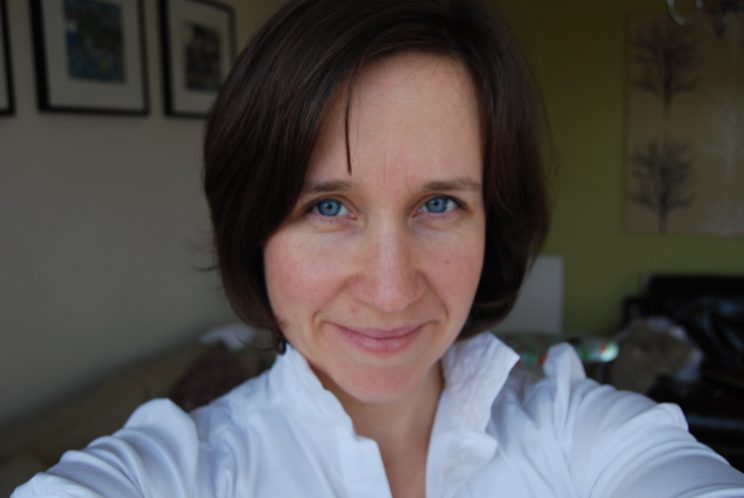DR Trudi Gillespie
Trudi was a truly talented microscopist, with an unparalleled enthusiasm for optical imaging. She showed this every day through her work first as facility manager at IMPACT, then the CALM facility at the University of Edinburgh, and through her work with the SMS, where she acted as treasurer for many years.
Trudi, whilst serious and focussed on her science, was a very kind person with a very positive approach, and was an absolute pleasure to be around, never taking herself too seriously. After her retirement in 2019 due to bad health, she continued to work as a volunteer, educating disadvantaged youths in Dundee. She put her microscopy skills to use to take fantastic photographs – ‘it’s all just the same concepts with different names’ she’d often assure us. She also had time to enjoy time with her husband Philip, brew her own beer, knit anything that she could think of, compete in dressage competitions with her horse and walk her beloved dog Chip. She will be greatly missed not only by those who worked directly with her, but by the whole community.

Trudi wrote in March 2019:
… “I’m writing to say goodbye to you all, unfortunately it’s not the ‘I’m leaving work and heading to pastures new’ kind of goodbye rather it’s the ‘I’ve retired from work due to having terminal cancer’ kind of goodbye. So I hope you will read on and indulge me as I put pen to paper, in an electronic sense.
I have, over the last thirteen years, while running imaging facilities at the University in both the Centre for Integrative Physiology and the Centre for Inflammation Research, had the indisputable pleasure of spending one on one time in a darkened room with a great number of you! And through teaching many of you to use confocal microscopes I have had the great privilege of observing the world at a cellular level, of seeing many of you come to appreciate imaging (and some physics) and of how many of you have taken imaging forward in your research and careers. Managing an imaging facility never came up during careers advice at school, but I’m so glad that over the last twenty-five years of my career I’ve found myself working daily with microscopes. I genuinely have enjoyed my work and have been fortunate to become good friends with many of you over this time.” …
…” I’m not entirely sure of the most appropriate way to end a ‘so long, I’m away to die’ email. And so I find myself thinking, as I have often done in an existential confocal experiment crisis, of the laws of physics, of Schrödinger’scat and a little bit of neuroscience.
To paraphrase the, now dead, author and physician, Paul Kalanithi1 ‘before my terminal cancer was diagnosed, I knew that someday I would die, but I didn’t know when. After the diagnosis, I knew that someday I would die, but I didn’t know when. But I knew it acutely’. As Paul Kalanithi so accurately observed ‘we are all living and yet dying at the same time, the fact of death is unsettling, yet there is no other way to live’. Which leads succinctly on to Schrödinger’s thought experiment that poses the question ‘when does a quantum system stop existing as a superposition of states and become one or the other?’
The first law of thermodynamics tells us that no energy gets created in the universe, and none is destroyed. I take great comfort from knowing that when I am dead, when my quantum system has settled on its final state, all the energy that made me ‘me’, every vibration, every wave form of every particle will remain in this world, consistent across time and space. That according to the law of the conservation of energy, when I die not a bit of me will be gone, my energy will still be hanging around; I will just be a lot less orderly. And the knowledge that I have had the privilege to share with many of you, the vibrations of the sound waves when I have politely reminded you to treat the objective lenses with respect and the images formed when photons reflected from my face have focused onto your retinas. These will all remain, as calcium spikes in a sub-set of your neurons, as action potentials and the release of neurotransmitters in your brains. As Prof Sue Black2 writes “In his poem ‘So Many Lengths of Time’ Brian Patten suggests that ‘a man lives for as long as we carry him inside us’” and that certainly rings true for me, or as Kylie Minogue3 sang ‘I just can’t get you out of my head’ ;-). We cannot die as long as there are people who remember us.
So all that is left for me to say is thank-you for all the good times, for the laughter, for all the love and kindness and for the pure enjoyment of being able to observe life on a cellular level.
Remember me well.
Trudi”
1 Kalanithi, P., (2016). When breath becomes air (First edition). New York: Random House.
2 Black, S., (2018) All that remains (First edition). Transworld Publishers, London
3 Minogue, K., (2001) Can’t get you out of my head. Fever. Parlophone, Australia
